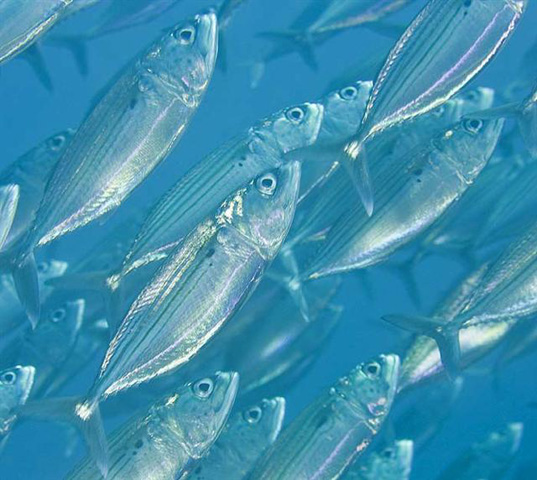| Scombridae (Mackerels, tunas, bonitos), subfamily: Scombrinae |
| 36 cm (male/unsexed); 42.1 cm TL (female); max.weight: 859.0 g; max. reported age: 4 years |
|
pelagic-neritic; marine; depth range 20 - 90 m, oceanodromous |
| Indo-West Pacific: Red Sea and East Africa to Indonesia, north to the Ryukyu Islands and China, south to Australia, Melanesia and Samoa. Entered the eastern Mediterranean Sea through the Suez Canal. |
|
Dorsal spines (total): 8-11; Dorsal soft rays (total): 12-12; Anal spines: 0-0; Anal soft rays: 12-12. Head longer than body depth. Maxilla partly concealed, covered by lachrymal bone but extending to about hind margin of eye. Bristles on longest gill raker 105 on one side in specimens of 12.7 cm, 140 in 16 cm, and 160 in 19 cm fork length specimens. A black spot on body near lower margin of pectoral fin. Interpelvic process small and single. Swim bladder present. Anal spine rudimentary.
Description: Characterized further by silvery body color with several dark stripes on upper half side, upper ones breaking into spots posteriorly; whole body covered by scales, those at anterior part larger but not developed as a corselet; moderately compressed body; large mouth, maxilla extending posterior to rear margin of eye; very small teeth in jaws, none on vomer or palatines (Ref. 90102). |
| Adults occur in coastal bays, harbors and deep lagoons, usually in some turbid plankton-rich waters. Form schools. Feed on phytoplankton (diatoms) and small zooplankton (cladocerans, ostracods, larval polychaetes, etc.) (Ref. 9684). Small groups were seen eating eggs of Cheilio inermis straight after spawning (Ref. 48637). Adult individuals feed on macroplankton such as larval shrimps and fish. Eggs and larvae are pelagic (Ref. 6769). Generally marketed fresh, frozen, canned, dried-salted, and smoked; also made into fish sauce (Ref. 9684). |
|
Least Concern (LC); Date assessed: 01 March 2022 Ref. (130435)
|
| harmless |
Source and more info: www.fishbase.org. For personal, classroom, and other internal use only. Not for publication.
